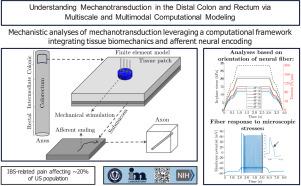通过多尺度和多模态计算建模了解远端结肠和直肠的机械传导。
IF 3.3
2区 医学
Q2 ENGINEERING, BIOMEDICAL
Journal of the Mechanical Behavior of Biomedical Materials
Pub Date : 2024-10-18
DOI:10.1016/j.jmbbm.2024.106771
引用次数: 0
摘要
大肠内脏疼痛是肠易激综合征(IBS)的主要症状,也是患者到消化科就诊的主要原因。这种疼痛是由远端结肠和直肠(结直肠)的机械性扩张所引发的。因此,负责将结肠直肠机械刺激转化为神经动作电位的感觉传入的机械传导过程在肠易激综合征相关肠痛中起着核心作用。在本研究中,我们将结肠直肠生物力学和传入神经编码的实验结果结合到一个综合计算模拟框架中,旨在加深我们对结肠直肠机械传导的理解。为此,我们建立了一个三层纤维增强有限元模型,该模型准确地复制了小鼠结直肠的非线性、异质性和各向异性机械特性。该模型有助于计算单个传入末梢周围的局部机械应力和应变,而这些末梢的直径只有微米级。然后,我们整合了神经膜模型,模拟传入神经对传入末梢微观应力和应变的动作电位编码。我们的多尺度模拟框架能够评估有关动作电位产生的机械门控的三种假设:(1) 轴向应力主导机械敏感通道的机械门控,(2) 轴向应力和周向应力都有作用,(3) 膜剪切应力占主导地位。此外,我们还探讨了传入末梢的方向如何影响神经编码特性。这一计算框架不仅可以在长期内脏超敏的背景下对结肠直肠机械传导进行虚拟研究,还可以指导新实验研究的发展,从而揭示肠易激综合征相关肠痛的神经和生物力学机制。本文章由计算机程序翻译,如有差异,请以英文原文为准。

Understanding mechanotransduction in the distal colon and rectum via multiscale and multimodal computational modeling
Visceral pain in the large bowel is a defining symptom of irritable bowel syndrome (IBS) and the primary reason that patients visit gastroenterologists. This pain is reliably triggered by mechanical distension of the distal colon and rectum (colorectum). Consequently, the process of mechanotransduction by sensory afferents, responsible for translating mechanical colorectal stimuli into neural action potentials, plays a central role in IBS-related bowel pain. In this study, we aim to enhance our understanding of colorectal mechanotransduction by combining experimental findings in colorectal biomechanics and afferent neural encoding within a comprehensive computational simulation framework. To achieve this, we implemented a three-layered, fiber-reinforced finite element model that accurately replicates the nonlinear, heterogeneous, and anisotropic mechanical characteristics of the mouse colorectum. This model facilitates the computation of local mechanical stresses and strains around individual afferent endings, which have diameters on the micron-scale. We then integrated a neural membrane model to simulate the encoding of action potentials by afferent nerves in response to microscopic stresses and strains along the afferent endings. Our multiscale simulation framework enables the assessment of three hypotheses regarding the mechanical gating of action potential generation: (1) axial stress dominates mechanical gating of mechanosensitive channels, (2) both axial and circumferential stresses contribute, and (3) membrane shear stress dominates. Additionally, we explore how the orientation of afferent endings impacts neural encoding properties. This computational framework not only allows for the virtual investigation of colorectal mechanotransduction in the context of prolonged visceral hypersensitivity but can also guide the development of new experimental studies aimed at uncovering the neural and biomechanical mechanisms underlying IBS-related bowel pain.
求助全文
通过发布文献求助,成功后即可免费获取论文全文。
去求助
来源期刊

Journal of the Mechanical Behavior of Biomedical Materials
工程技术-材料科学:生物材料
CiteScore
7.20
自引率
7.70%
发文量
505
审稿时长
46 days
期刊介绍:
The Journal of the Mechanical Behavior of Biomedical Materials is concerned with the mechanical deformation, damage and failure under applied forces, of biological material (at the tissue, cellular and molecular levels) and of biomaterials, i.e. those materials which are designed to mimic or replace biological materials.
The primary focus of the journal is the synthesis of materials science, biology, and medical and dental science. Reports of fundamental scientific investigations are welcome, as are articles concerned with the practical application of materials in medical devices. Both experimental and theoretical work is of interest; theoretical papers will normally include comparison of predictions with experimental data, though we recognize that this may not always be appropriate. The journal also publishes technical notes concerned with emerging experimental or theoretical techniques, letters to the editor and, by invitation, review articles and papers describing existing techniques for the benefit of an interdisciplinary readership.
 求助内容:
求助内容: 应助结果提醒方式:
应助结果提醒方式:


